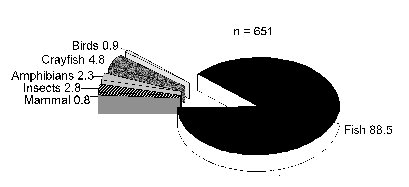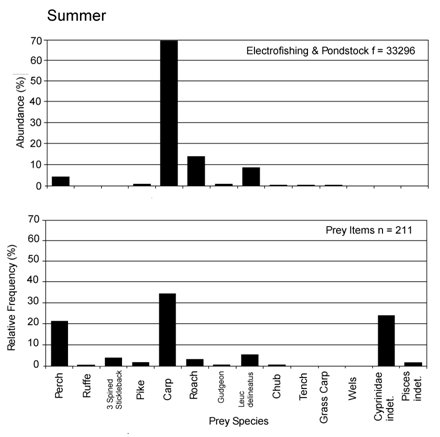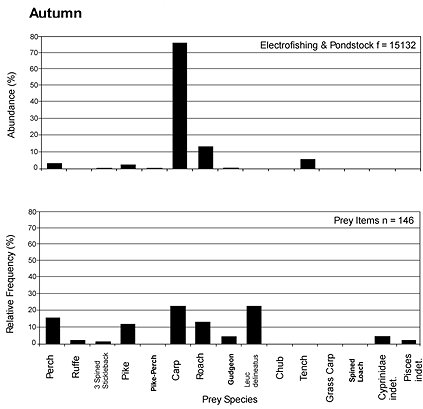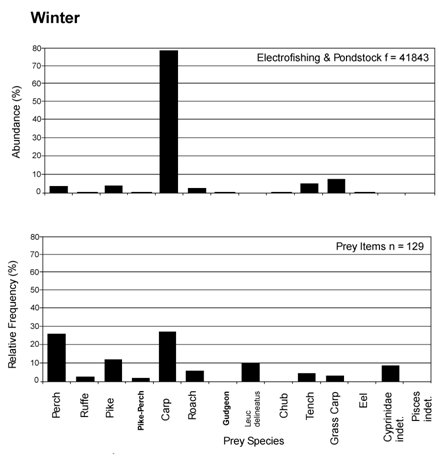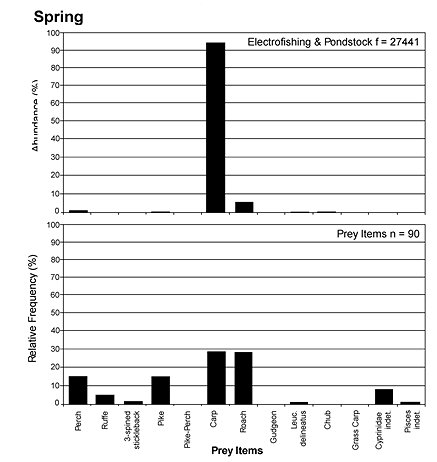 |
Last Update:
Thursday November 22, 2018
|
| [Home] |
Due to the severe decline of Eurasian otter (Lutra lutra L.) populations in many European countries the species is classified as highly endangered ( Mason and Macdonald 1986 ). In Germany it is listed among the country’s most endangered mammals and is classified in the “Red List“ as “threatened by extinction“ ( Nowak et al. 1994 ). In north-eastern Saxony, a breeding otter population still exists. This might be a focus from which the species may expand to areas where it is currently extinct. This population which has a small distribution exists in the Oberlausitz pondland ( Ansorge 1994 ). Considering the current status of otters, Saxony has a high responsibility for the conservation of the species within its borders. In 1993 the Saxonian State Government implemented the “Otter Conservation Programme“. The coordination lies with the Saxonian Department of Environment and Geology in Radebeul/Dresden. As part of the “Conservation Programme“, a study of the feeding ecology of otters in the Oberlausitz pondland was undertaken between June 1994 and June 1995. Spraints were collected in a fish-pond area and prey-fish availability estimated by pond-stock data and electrofishing. Such investigations on otter diet in an economically-used pond area had not been undertaken until now. Steps, to conserve the food resources and the wetland habitats of otters, are urgently required for the protection of the core populations in the Oberlausitz pondland. The aims of the study were: 1. To record seasonal availability and dispersion of the main prey of otters in the pondland, 2. To determine seasonal food utilization by otters in the pondland. STUDY AREA The study area is located within the Biosphere Reserve “Oberlausitzer heath and pondland” in eastern Saxony. Since the Middle Ages the Oberlausitz pondland - the largest interconnected pond area in Germany - is characterized by carp-pond farming. Carp (Cyprinus carpio) are classified by age/size and stocked in different densities in the ponds. Beside carp, other species may be stocked but in much lower densities; these include pike (Esox lucius), tench (Tinca tinca), perch (Perca fluviatilis), pike-perch (Stizostedion lucioperca), wels (Silurus glanis) and grass carp (Ctenopharyngodon idella). On average the ponds are 1 to 1.3 m deep and their important characteristic is their regular draining during winter. There are a lot of carp-ponds with near natural shores and a wide system of ditches ensuring the necessary habitat structures with favourable feeding conditions for otters. The study area covers 300 ha, contains 13 fish-ponds from 550 m² to 21 ha of size, totaling 75 ha of water surface. A small river (7 m wide, up to 1.5 m deep) runs also through the area. Both running and still waters of different sizes, bank structures and with diverse food availability are close together and otters can easily move between them. MATERIAL AND METHODS Recording otter signs and diet The study area, particularly along pond and river banks, and ditches was searched for presence of otter signs such as spraint sites, spraints, tracks etc. An average of 130 “collecting sites” was visited over several consecutive days of each month, always in the same sequence. Only fresh spraints, less 24 h old, were collected, placed separately in polythene bags and stored deep-frozen. In the laboratory, they were oven-dried at 50°C for 48 h, weighed and soaked for 24 h in 0.2 l saturated solution of concentrated washing powder. This solution was sieved through a 1-mm-sieve, the remains transferred to filter paper in a Petri dish to dry. For spraint analysis the undigested remains (e. g. scales, vertebrae, bones, teeth, fur, feathers) were identified from reference collections and with special identification keys. Identification of fish remains in the spraints was mostly possible to species level. Cyprinids (Cyprinidae) could only be identified to species level if pharyngeal teeth, operculae, otoliths or, exclusive for carp, praemaxillare or dented fin rays were present. In the absence of these characteristic structures the fish was considered as “unidentified cyprinid”. Recording fish availability in the study area
For comparison of fish availability in the river and in the ponds the recorded abundances of the different fish species were calculated as number of individuals per hectare area of water. The data are presented as percentage of occurrence for each fish species. Jacobs Index of Preference ( Jacobs 1974 ) was calculated to compare the proportions of prey fishes in the spraints to the available fishes in the environment, in order to assess the degree of preference for a fish category. Only fish categories presented in the diet and in the environment were used in the calculations. Jacobs Index of Preference (D) is defined as: D = (r-p) / (r+p-2rp) (r = relative proportion of prey category in the diet; p = relative proportion of the same prey category in the environment). RESULTS The results are based on the analysis of 359 spraints, collected between June 1994 and June 1995.
The comparison between diet of the otters and prey fish availability is given in Fig. 2.1-2.4 for all four seasons. Summer ( Fig. 2.1 ) Seventy per cent of all fishes in the study area were carp and were found most frequently (47 %) in spraints. Perch was found in 30 % of the spraints, though they made up only 4 % of fish population. Roach took the second most common fish availability (14.5 %) but it was found in only 4.5 % of the spraints. L. delineatus, small cyprinids, made up 9 % of available fish, i. e. more than twice as much as perch, but were represented in only 7.6 % of the spraints. In this season the otters prefered perch (Jacobs Index of Preference: D=0.72) and showed a negative preference for carp (D=-0.61), roach (D=-0.66) and L. delineatus (D=-0.23). Availability of other prey fish species was fairly low and were hardly found in the otter diet. Autumn ( Fig. 2.2 ) In the autumn several species were found more frequently in the diet than would be expected by the availability data. Again, carp (74 %) made up the biggest part of the fish population and found in about half the spraints. Although the small cyprinid species, L. delineatus, was represented in the diet almost as frequently as carp, it was not caught in the electrofishing. Perch and pike were found ten times more frequently in spraints than expected by availability. There was again a negative preference (D=-0.81) for carp and a positive preference for perch (D=0.69) and pike (D=0.67). Tench, though available, did not occur in the otter diet. Winter ( Fig. 2.3 ) Even in winter carp (78 %) was most available in the study area because six ponds were stocked with carp in fairly high densities during the cold season. Perch (44 %) was found in almost the same number of spraints as carp (45 %). Pike occured five times more frequently in spraints than expected by availability. Also in winter, the otters seemed to prefer perch (D=0.82) and pike (D=0.51) to carp (D=-0.81). Spring (Fig. 2.4) In spring 93 % of all available prey fishes in the study area were carp but roach, only 4.6 % of available fish, was found just as much as carp in the otter diet. This displays a positive selection for the cyprinid species roach (D=0.78) contrary to carp (D=-0.94). There was a positive preference for perch (D=0.86) and pike (D=0.98), both species occured in more than 20 % of the spraints, though they were available only in quite low numbers in comparison to carp. DISCUSSION AND CONCLUSIONS The results of spraint analysis of otters in the Oberlausitz pondland showed that fish is the most important prey item eaten in this fish-farming area during all seasons of the year. These results are similar to other studies from freshwater habitats in northern and central Europe ( Erlinge 1967 , Webb 1975 , Wise et al. 1981 , Hansen and Jacobsen 1992 , Hofmann and Butzeck 1992 , O’Sullivan 1994 ). In southern Europe other prey categories, like amphibians or crayfish, are an important contribution to the otter diet ( Macdonald and Mason 1982 , Prigioni et.al. 1986 , Adrian and Delibes 1987 ). The diet of the otters in the Oberlausitz pond area consists mainly of individuals of the Cyprinidae, Percidae and Esocidae families. Out of 16 fish species which are found in the study area only five were eaten in an amount worth mentioning. The main prey fish, carp and perch, made up around 44 % of the total diet and 50 % of the fish diet of otters. Crayfish are considered an important prey item for otters in other studies ( Erlinge 1967 , Hofmann and Butzeck 1992 ). In Spain, for example, Adrian and Delibes (1987) found up to 80 % in the otter diet was crayfish. In the present study, crayfish were indeed the second most eaten prey group, but they contributed little (4.8 %) to the otter diet. Possibly, crayfish occur in much higher densities in these otter study areas, and, therefore, are eaten by otters more frequently. No data of crayfish abundance or availability are given in these studies. Amphibians, insects, birds and small mammals were only occasionally taken by the otters in this carp-pond area. These are considered important alternative prey if for instance fish abundance/availability is declining (cf. O`Sullivan 1994 ), however, this does not seem to be the case here. Specimens of the Cyprinidae family are the major prey in the present study as in other eutrophic lakes and streams ( Wise et al. 1981 , Hansen and Jacobsen 1992 , Hofmann and Butzeck 1992) . Some studies ( Erlinge 1967 , Webb 1975 , Hofmann and Butzeck 1992 ) have found cyprinids to be eaten less often in summer than during the rest of the year. This is not the case at this study. This is probably due to carp being available throughout the year. They made up 70-93 % of all prey fish in the study area and were found in over 40 % of spraints in all seasons. Carp are bottom-living fish and prefer to stay under overhanging bankside vegetation and aquatic plants. Because of the shallow nature of fish-ponds and, apart from a few reed beds nearly no aquatic vegetation, these slowly moving fish fall easy prey to otters. In other studies (e. g. Kruuk and Moorhouse 1990 ) slow-moving and bottom-living species are taken most by otters. In winter carp are stocked in the ponds in much higher densities than in summer. These densely packed and almost torpid carp are easy to capture. However, it has been observed that otters ate only the flesh and left the bony structures of large prey fish. This behaviour might be a problem with large carp and would lead to their importance being underestimated in spraint analysis. Remains of large fish were seldom found in the study area, might be because fish carcases abandoned by otters were quickly eaten by other animals like fox and heron (Geidezis 1995, pers. obs.). In the study area the most common river fish is roach. Though available in higher numbers during the summer, their presence in spraints was the lowest recorded. This is probably due to the fishes’ increased activity when water temperature is higher ( Webb 1975) , making them harder for the otter to catch. The seasonal variation in roach can also be influenced to their migratory behaviour at certain times of the year, e. g. they gather in shoals to overwinter and to spawn in spring. Shoaling may make them capture by otters easier. Also, in autumn pond-draining leads to an increase in fish numbers in the river for a short time. In the present study roach was taken by otters more frequently in autumn and spring than expected by availability data. Otters ate L. delineatus in high numbers, especially in autumn. These small, shoal-living fish were found in 50 % of spraints, though, these species was not caught when electrofishing in autumn. As mentioned above, at the end of September pond-draining starts and at that time many L. delineatus and other species enter the river. When electrofishing was carried out at the end of November numbers of these fish species in certain areas of river were probably decreasing. It seems easy for otters to catch this fish (mostly under 5 cm long) because some spraints contained up to 30 individuals and nearly nothing else. Tench, though, third prey availability in summer, autumn and winter, occured only in the winter otter diet. Tench stop feeding and hibernate in the bottom of ponds or rivers in winter, probably when they are least readily available to otters. This species, however, was only found in the spraints collected in winter. A reason could be, because tench were stocked together with carp in two small winter-ponds (each around 550 m²), foraging otters in these ponds frightened the tench. Also, it could be possible that tench, hiding in the mud, are a particularly easy prey because of the “otter’s sense“ for prey (e. g. eel) in the mud. It is worth mentioning that no carp were left in these ponds but many tench were still present at harvesting in spring. Otters appear to prefer other prey fish species if they are readily available. Perch was eaten more frequently by otters in all seasons, especially in winter, than expected by relative availability data. A tendency that percids are very important in winter was also found by Erlinge (1967) , Webb (1975) , Jenkins et al. (1979) and Hofmann and Butzeck (1992) . Observations on foraging behaviour of otters in Otter-Zentrum, Hankensbüttel (Rogoschik 1995, pers. comm.) showed perch an easy prey for otters because of its anti-predator-behaviour - they became motionless when an otter approached and therefore easy for the carnivore to catch. Feeding trials carried out in the Otter-Zentrum, Hankensbüttel (Jurisch and Geidezis in prep.) showed that nearly all perch remains are defecated within 24 hours (cf. Carss and Parkinson 1996 ). The problem of overestimation of perch in spraint analysis is thus restricted. Pike contributed only a small part to otter diet in summer but was taken more frequently than expected by availability data in autumn, winter and spring. Pike stays mostly between aquatic plants close to the bank and lies in wait for its prey. However, this species has only a low capability of sustained swimming. This is probably why it is not difficult for otters to catch. This is especially true in autumn and winter, when plant cover is missing. In conclusion the results of the study, it seems that otters are specialized feeders on fish in this pond area, despite the presence of other prey such as crayfish, amphibians, small mammals etc. which are available in large numbers as found by regular trapping or counting. Of all fish species, carp was the most readily available during all seasons (70-93 %) but was found on an average in only 46 % of all analysed spraints, reflecting a negative preference for carp. On the other hand only 3 % of all available prey was perch but this species was found in 33 % of the spraints, signifying a positive selection for perch. The otter is considered as an opportunistic predator, taking whatever is available. But these results seem to show that otters do not always feed on the most abundant prey (fish) but are selective. Probably behaviour (flight behaviour, catchability), distribution (pond or river) and/or even nutrient value of the potential prey influences the otter’s choice. The frequent occurrence of perch and pike in the otter diet was striking. These species are predators and probably show a different flight behaviour as for instance roach, which might facilitate catching by otters. Acknowledgements - This work was possible thanks to the invitation of S. Anderson from the Nature Conservancy, Tucson, Arizona to visit the Río Yaqui. Thanks to P. Warren, R. Mesta from U.S. Fish and Wildlife Services and the participants of the expedition, D. Gori and S. Wilson, Judy and Jim. Thanks to H. Medina from CIDESON who drove the treacherous dirt roads of Sierra Madre Occidental. REFERENCES
Adrian, M.I., Delibes, M. (1987). Food habits of the otter (Lutra lutra) in two habitats of the Donana National Park, SW Spain. J. Zool., Lond. 212: 399-406. |
| [Copyright © 2006 - 2050 IUCN/SSC OSG] | [Home] | [Contact Us] |
